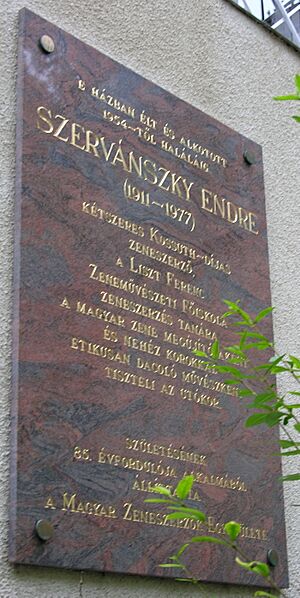Endre Szervánszky facts for kids
Endre Szervánszky (born December 27, 1911 – died June 25, 1977) was a talented Hungarian composer. He created many different kinds of music during his life.
Contents
About Endre Szervánszky
Endre Szervánszky was born in a place called Kistétény. He started his music journey by learning to play the clarinet. He studied at the Budapest Academy of Music from 1922 to 1927.
After playing in various orchestras, he decided to learn more about composing music. He returned to the Budapest Academy and studied composition with Albert Siklós from 1931 to 1936.
Later, he worked for Hungarian Radio, where he arranged music for them. He also taught music theory to students. In 1948, he became a professor of composition at the Budapest Academy. This meant he taught others how to write music.
His Musical Style
Endre Szervánszky became well-known for his music, starting with his First String Quartet (1936–1938). Early in his career, his music was inspired by two other famous Hungarian composers: Zoltán Kodály and Béla Bartók. Some of his works from this time include the Clarinet Serenade (1950) and the Flute Concerto (1952–1953).
In the 1950s, Szervánszky started writing bigger pieces of music. One of his longest works was the Concerto for Orchestra. He wrote this piece to honor a poet named Attila József. Each of its five parts was based on something József had written. This concerto also showed the influence of Bartók.
Around this time, Szervánszky became interested in a new way of composing called serialism. This is a method where composers use a specific order of notes to create their music. You can hear this in his String Quartet No. 2 (1956–1957) and Wind Quintet No. 2 (1957).
In 1959, he composed Six Orchestra Pieces. For this work, he used a special type of serialism called 12-note serialism. This piece is also known for its interesting use of percussion instruments.
Szervánszky did not write another major work until 1963. This was an oratorio called Requiem. An oratorio is a large musical piece for voices and orchestra. His Requiem was based on a text by János Pilinszky and was about the concentration camp of Auschwitz. Other works that followed include his Variations (1964) and the Clarinet Concerto (1965).
Helping Others
Endre Szervánszky received a very special award called "Righteous Among the Nations". The State of Israel gives this award to people who are not Jewish but risked their own lives to help Jewish people escape from the Nazis during World War II. This shows his bravery and kindness.
His Family
Endre Szervánszky came from a talented family. His brother, Jenö Szervánszky, was an artist, and his other brother, Peter Szervánszky, was a violinist. He was also the uncle of Valeria Szervánszky.
Endre Szervánszky passed away in Budapest in 1977.
Notable Students
Endre Szervánszky taught many students during his time as a professor. One of his notable students was:
- Ákos Rózmann
Types of Music He Wrote
Endre Szervánszky composed music for many different instruments and groups. Here are some of the types of works he created:
Stage and Vocal Music
He wrote pieces that involved singing or were meant for the stage, like a "dance play" called "Oriental Tale." He also composed cantatas, which are like short oratorios, and songs for voices.
- "Oriental Tale" (a dance play), 1948–1949
- "Folksong Suite," 1949
- "Soldier’s Cantata," 1949
- "Spring Breeze" (cantata), 1950
- 8 Petőfi Songs, 1951
- "Dark Heaven" (oratorio), 1963
Orchestra Music
He wrote many pieces for a full orchestra, which is a large group of musicians playing different instruments.
- 3 divertimentos, 1939, 1942, 1943
- Serenade for strings, 1947–1948
- Rhapsody, 1950
- Serenade for clarinet and orchestra, 1950
- Flute Concerts, 1952–1953
- Concerts for Orchestra, 1954
- 6 Orchestral Pieces, 1959
- Variations, 1964
- Clarinet Concerto, 1965
Chamber Music
Chamber music is written for a small group of instruments, usually one player per part.
- String Quartet No. 1, 1936–1938
- 20 Little Duos for 2 violins, 1941
- Sonata for violin and piano, 1945
- Trio for flute, violin, and viola, 1951
- Sonatina for flute and piano, 1952
- Wind Quintet No. 1, 1953
- String Quartet No. 2, 1956–1957
- Wind Quintet No. 2, 1957
Piano Music
He also composed pieces specifically for the piano, sometimes for one player and sometimes for two players (four hands).
- Folksong Suite for 4 hands, 1935
- Little Suite, 1939
- Sonatina, 1941
- Sonatina for 4 hands, 1950


